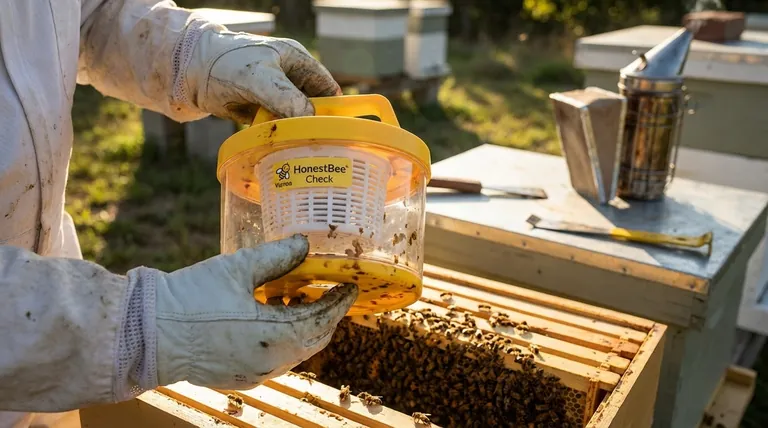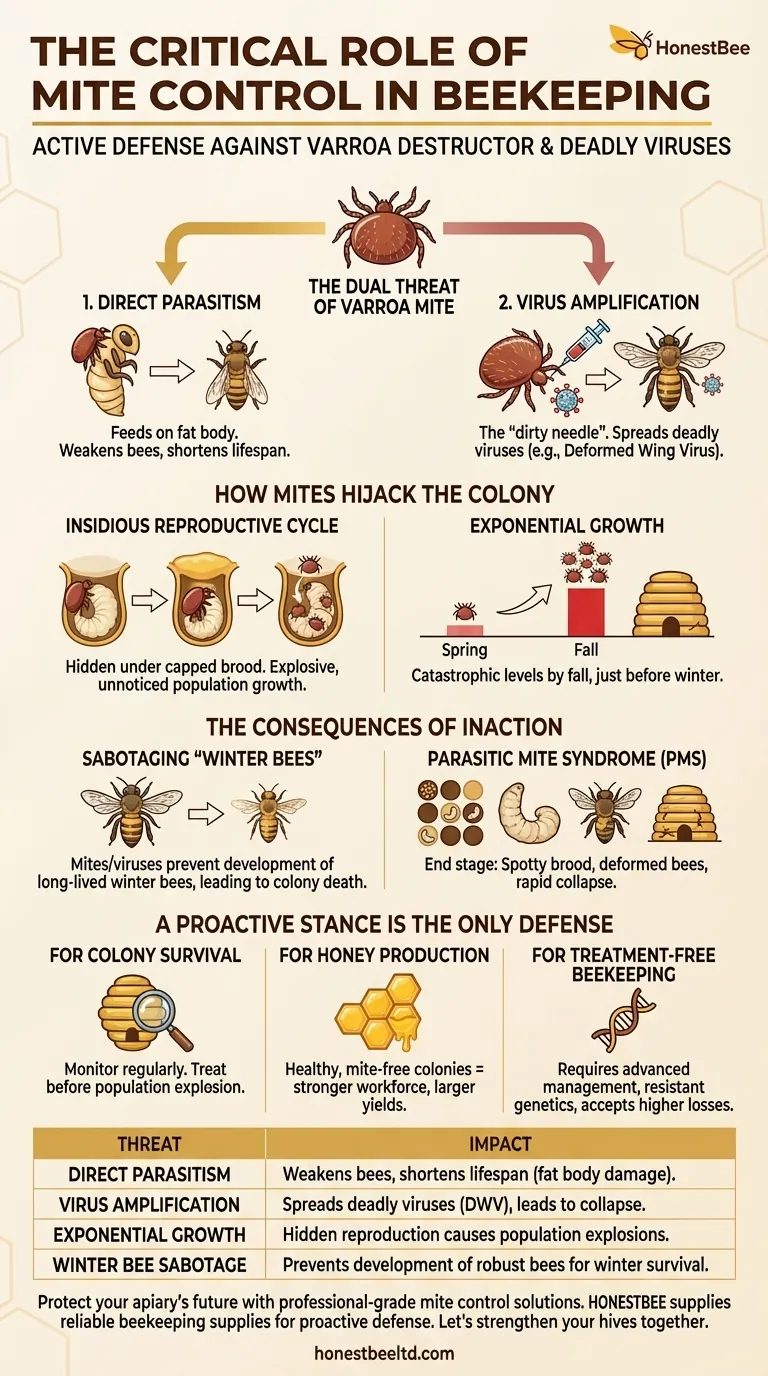In modern beekeeping, mite control is the single most critical factor determining whether a honeybee colony lives or dies. Its role is not merely hive maintenance but an active defense against the Varroa destructor mite, a parasite that weakens bees directly and, more critically, transmits a cocktail of deadly viruses that can quickly lead to colony collapse.
The core purpose of mite control is not simply to reduce the number of mites in a hive. It is to suppress the viral load that these mites amplify and inject into the bees, which is the ultimate cause of colony failure.

The Dual Threat of the Varroa Mite
Understanding why mite control is so essential requires recognizing that Varroa mites attack a colony on two distinct fronts: as a direct parasite and as a disease vector.
Direct Parasitism: Weakening the Host
The Varroa mite feeds on the bee's fat body tissue, which is a vital organ responsible for immune function, detoxification, and energy storage.
When a mite feeds on a developing bee (pupa), it results in a smaller, weaker adult bee with a significantly shorter lifespan.
Virus Amplification: The Hidden Killer
This is the far more destructive aspect of a mite infestation. Mites act like a "dirty needle," injecting viruses directly into the bee's circulatory system as they feed.
Most notably, mites activate and spread Deformed Wing Virus (DWV). In a low-mite environment, DWV is often a harmless, latent infection. In a high-mite hive, it becomes a lethal epidemic, causing the characteristic deformed wings and colony-wide immune suppression that leads to collapse.
How Mites Hijack the Bee Colony
The mite's life cycle is perfectly synchronized with its honeybee host, allowing for explosive, often unnoticed, population growth.
An Insidious Reproductive Cycle
A female mite enters a brood cell just before the bees cap it with wax. Safely sealed inside, she feeds on the developing bee larva and lays several eggs.
These offspring mature and mate within the sealed cell. When the new adult bee emerges, the original mother mite and her newly-mated daughters emerge with it, ready to repeat the cycle.
The Problem of Exponential Growth
Because their reproduction is hidden under the capped brood, a beekeeper may not realize the severity of the problem until it's too late.
A small, manageable mite population in the spring can grow exponentially throughout the summer, reaching catastrophic levels by fall—precisely when the colony is raising its vital winter bees.
The Consequences of Inaction
Failing to manage mite levels doesn't just weaken a colony; it sets it on a direct path to failure, a condition often referred to as Parasitic Mite Syndrome (PMS).
Sabotaging "Winter Bees"
For a colony to survive the winter, it must raise a generation of long-lived "winter bees" that have high fat body reserves.
Mites and the viruses they transmit prevent these bees from developing properly. The resulting bees are too weak to survive the long winter months, leading to the colony dwindling and dying out before spring.
Parasitic Mite Syndrome (PMS)
This is the end stage of a Varroa infestation. Symptoms include a spotty brood pattern, larvae slumping in their cells, bees with deformed wings, and a rapidly shrinking population.
By the time these signs are obvious, the viral load in the colony is typically too high to overcome, and the colony is almost always lost.
A Proactive Stance is the Only Defense
Your approach to mite control must be based on a clear understanding that prevention is vastly more effective than trying to save a collapsing hive.
- If your primary focus is colony survival: You must prioritize regular monitoring to assess mite levels and treat proactively before populations explode in late summer.
- If your primary focus is honey production: Understand that healthy, mite-free colonies are productive colonies; effective mite management directly translates to a stronger workforce and larger honey yields.
- If your primary focus is treatment-free beekeeping: Recognize this requires advanced management, mite-resistant genetics, and a willingness to accept higher colony losses as you select for truly resilient traits.
Ultimately, consistent and effective mite management is the foundational act of responsible beekeeping, giving your colonies the ability to thrive.
Summary Table:
| Threat | Impact on Honeybee Colony |
|---|---|
| Direct Parasitism | Weakens bees, shortens lifespan by damaging fat body tissue. |
| Virus Amplification | Spreads deadly viruses like Deformed Wing Virus (DWV), leading to collapse. |
| Exponential Growth | Hidden reproduction in brood cells causes population explosions. |
| Winter Bee Sabotage | Prevents development of robust bees needed for winter survival. |
Protect your apiary's future with professional-grade mite control solutions.
Commercial beekeepers and distributors understand that effective mite management is not an option—it's the foundation of a profitable and sustainable operation. HONESTBEE supplies the reliable beekeeping supplies and equipment you need to implement a proactive defense against Varroa destructor mites.
Let's strengthen your hives together. Contact our wholesale team today to discuss equipment and treatment options tailored for commercial-scale success.
Visual Guide

Related Products
- Varroa Easy Check Mite Tester Kit Counter Alcohol Wash Jar
- Cotton Beekeeping Suit and Round Hat with Veil Bee Keeper Protective Gear
- Stainless Steel Queen Grafting Tool for Beekeeping and Bee Queen Grafting
- Beekeeper Cowboy Hat and Veil for Beekeeping
- Economy Polyester Beekeeping Jacket with Veil and Hat
People Also Ask
- What are some popular methods to measure Varroa mite load in beehives? Compare Accuracy & Bee Safety
- What is the Varroa EasyCheck used for? Accurate Mite Monitoring for Healthy Hives
- How often should varroa mite checks be performed using the alcohol wash method? Optimize Your Apiary's Health
- What is the Varroa EasyCheck and its purpose? Streamline Your Hive Health Monitoring
- How is the infestation percentage calculated after counting mites? Master Varroa Mite Monitoring



















